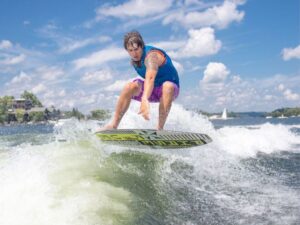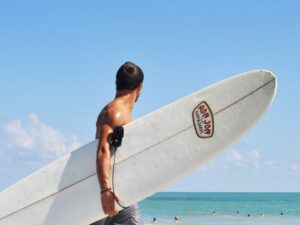As easy as it may sound, learning to surf is no child’s play. Of course, everyone has their own way of learning – some take the help of family or friends, while others learn through an instructor.
But is it possible to learn on your own?
Technically speaking, you can learn to surf independently without an instructor. While having an experienced instructor to guide you is always more helpful, learning on your own can have some benefits, too, provided you’re careful and dedicated during practice.
In this article, I’ll guide you through learning to surf independently. From choosing the right surfboard to proper safety measures– I’ll cover everything you need to know.
Why learn to surf on your own?
You are not dependent on the schedule or availability of an instructor. Besides the time, let’s not forget the money you’ll be saving– you can invest it in your gear instead.
Moreover, surfing solo allows you to discover and explore the sport at your own pace. You can experiment with different tricks and techniques without any external influences but with safety considerations.
You can navigate the waves and understand the waters without an instructor. Self-learning is a great way to understand and adapt to different surf conditions.
How difficult is it to learn surfing without a coach?
It takes work to learn to surf by yourself. Surfing requires proper technique and balance – both are easier to learn with guidance. Understanding the dynamics, such as waves, currents, and tides, is crucial for safe and effective surfing. Lastly, you’ll feel the need for real-time feedback sooner or later.
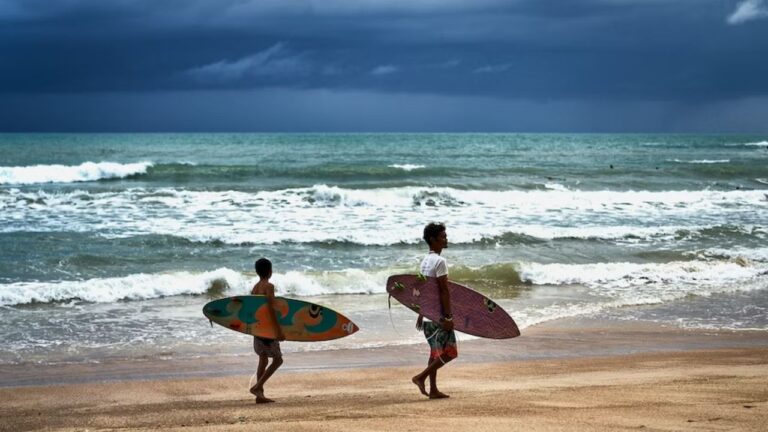
Safety is one of the most concerning challenges you’ll face. Surfing is risky and especially dangerous for beginners. One must be aware of potential hazards in the water, or your self-learning journey can take a really bad turn.
Most local coaches have a better understanding of the conditions and hazards specific to that area. They’ll also save you time in learning about ocean dynamics.
An instructor can help you choose which waves are the best to start with and guide you through varying surfing conditions. Also, learning to surf without proper guidance may lead you to develop poor techniques and forms.
Besides that, it does get a bit difficult for a beginner to choose equipment for themselves. A trainer, however, can help you decide on equipment that suits you the best, depending on your body type and local surf conditions.
These challenges may intimidate some of you, but remember, teaching yourself to surf is a good option. After all, it’s only sometimes feasible to hire a great surf coach and abide by their routines.
How to teach yourself to surf?
1. Be thorough in your research.
A. Choosing the right surf gear
The proper equipment will enhance your surfing experience and ensure your safety in the water. Let’s go through the key considerations for each piece of equipment individually.
Surfboard: Opt for a larger, more stable board that will offer better balance and buoyancy, making it easier to catch waves and maintain stability while standing up. A soft-top or foam board is an excellent choice for beginners due to its forgiving nature and durability.
Wetsuit: Wetsuits are selected depending on the water temperature and climate of your surfing location. Choose a wetsuit that suits your surfing conditions—thicker wetsuits for colder waters and thinner ones for warmer climates.
Leash: A surfboard leash is a crucial safety accessory that attaches to your ankle and keeps your board connected to you at all times.
Fins: Fins help stabilize your surfboard and improve maneuverability. As a beginner, you can start with a thruster setup (three fins) since it balances control and stability well.
Besides this main equipment, you should also look for some sun protection. Look for water-resistant sunscreen and invest in polarised sunglasses to reduce glare and protect your eyes.
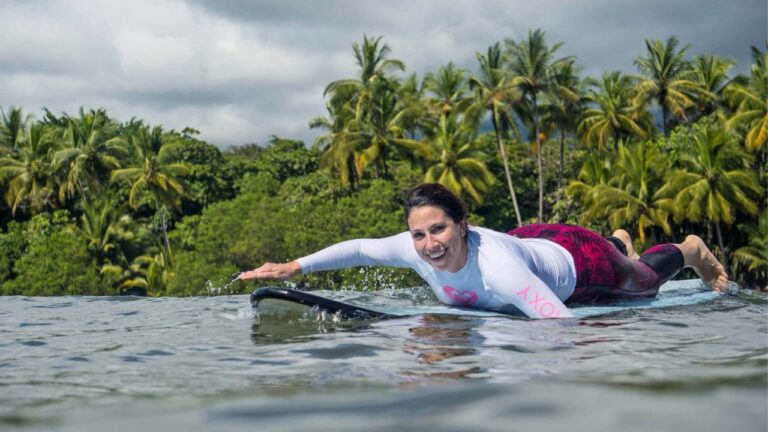
B. Choosing a safe location
The choice of your surf spot plays an important role in how your first few surf sessions unfold and your safety in the water. Every surf spot has different wave conditions, and waves can vary in size, power, and consistency.
Beginners generally benefit from smaller, slower waves with long rolling breaks, giving them ample time to practice basic techniques like paddling. Look for beaches with mellow and consistent waves and avoid areas with strong currents, reefs, or rocks.
Accessibility and crowd levels are additional factors when selecting a surf spot. Because you’re just starting, try to find a spot that is easily accessible, with parking and amenities nearby.
Important Tip: Tap into local knowledge by talking to the local surfers. They can provide great tips on the best times to surf, area-specific hazards to be aware of, and lesser-known breaks that may suit your skill level.
C. Common challenges for beginners
There are some common challenges that most beginners face when learning to surf.
- Balance and Stability: Maintaining balance on the surfboard can be difficult initially. It takes time to find your center of gravity and adjust to the constant motion of the waves.
- Paddling: Efficient paddling technique is important for you to catch waves.
- Wave Reading: Learning to read and anticipate waves is necessary for catching them on time. Beginners often need help assessing wave breaks, timing their paddling, and correctly positioning themselves.
- Wave Selection: Identifying suitable waves to catch is quite challenging. As a beginner, you may need help to gauge wave size, speed, and direction.
2. Learn the basics.
A. Catching Waves
Waves are created by the wind’s energy transferring to the water’s surface, forming ridges and troughs. As waves approach shallow areas, they break, creating the rideable face that surfers seek.
Watch the sets and observe how they break to determine the ideal moment to paddle. Aim to catch the wave just before it breaks, positioning yourself slightly ahead of the breaking section.
Paddle vigorously to generate speed and momentum once you’ve positioned yourself in the lineup. You’ll learn how to paddle in the next topic.
B. Paddling
Paddling is not only how surfers propel themselves toward incoming waves but also a means of maintaining balance and control while riding. It’s also the initial step to catching a wave and positioning yourself in the right spot to maximize your ride. Here’s how you paddle:
- Lie on your board with your chest centered on the board’s midpoint.
- Keep your legs extended behind you, and arch your back slightly to maintain stability.
- Start by cupping your hands and entering them into the water shoulder-width apart.
- Pull your hands back towards your hips sweepingly, using your entire arm and shoulder muscles to generate propulsion.
- Remember to keep your elbows high and avoid unnecessary splashing, which can slow you down.
- Flutter kick your legs relaxed and controlled, as excessive kicking can create unnecessary resistance.
- Focus on generating small but consistent kicks, keeping your legs near the water’s surface to avoid dragging.
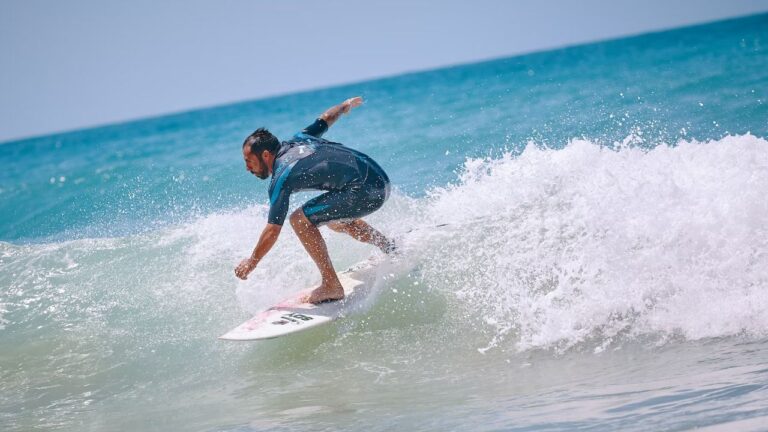
C. Standing up
Once you’ve caught the wave, it’s time to transition from paddling to standing up on your board—a move known as the pop-up.
- As the wave lifts you, bring your hands closer to your chest and push yourself up with an explosive motion, simultaneously swinging your feet underneath your body.
- Begin by positioning your feet parallel, shoulder-width apart, with your toes slightly forward. Distribute your weight evenly across both feet for stability.
- Experiment with slight adjustments to find your most comfortable and natural stance.
- Follow by quickly swinging your front foot forward and placing it near the board’s nose, completing the standing position.
- Keep your eyes fixed on the horizon or the section of the wave you intend to ride.
3. Create a practice routine.
A. Setting goals
Start by breaking down your overall objective into smaller, achievable goals. Your ultimate goal is to ride bigger waves, so you can set smaller goals, such as improving your paddling technique or mastering the pop-up motion.
Ensure these goals are specific, time-bound, and attainable to track your progress effectively.
- Begin each practice session with a warm-up routine.
- Allocate dedicated practice time to improve your paddling technique, focusing on arm positioning, stroke efficiency, and timing.
- Practice popping up motion on the beach or balance board to improve your muscle memory and agility.
- Incorporate yoga, balance board training, and core workouts to strengthen your stability muscles.
- Dedicate regular time to hit the waves and apply the skills you’ve been practicing.
B. Getting feedback
You must seek guidance from experienced surfers regularly. Embrace the learning process, and don’t be discouraged by setbacks. Take each setback or mistake as a lesson.
One effective method of learning from mistakes is recording your surfing sessions and analyzing your ways through video playback. You can ask a friend to capture your rides and review them together.
Look for areas where you can refine your stance, timing, and body positioning. Take note of any patterns or habits that may hinder your progress and actively work on correcting them.
Expert QnA
Q. How long does it take to learn to surf?
The time it takes to learn to surf can vary greatly depending on several factors, including your physical fitness, coordination, prior experience in other water sports, and the amount of time you dedicate to practicing.
Generally, you can learn to surf quite well in several weeks if you dedicate about two hours almost daily. However, note that to be a skilled surfer, one can take up to a year or two, depending on the time spent and ways of learning.
Q. Can you learn to surf if you don't know how to swim?
You can learn to surf without knowing how to swim. However, I strongly recommend against it. Also, knowing how to swim allows you to paddle effectively, maintain control of your surfboard, and position yourself in the lineup or catch waves.
Q. At what age do people start learning to surf?
People start learning to surf between the ages of 7 and 9. But that does not imply that you can not learn to surf when you’re older. There is no age limit to start learning, and it does not matter if you begin to learn surfing at 10, 20, or 30. You can learn to surf if you’re fit and passionate about it.


